Improving Customer Service at Marriott Hotel: A Report
VerifiedAdded on 2019/12/03
|12
|3267
|142
Report
AI Summary
This report provides a comprehensive analysis of customer service at Marriott Hotel. It begins with an introduction to the importance of customer service and its impact on market image. The report then examines customer needs analysis for different customer types (business, leisure, and event needs), followed by a customer feedback survey questionnaire designed to gather insights into customer satisfaction and areas for improvement. The methodology section details qualitative and quantitative data collection methods, including surveys and interviews. Based on the findings, the report recommends policy changes to address issues such as staff efficiency, leadership skills, and communication skills. The report also explores different communication types (verbal and non-verbal) and the benefits of technology tools like EPOS, touch screen systems, and message boards. A self-assessment questionnaire for staff training is included. The conclusion summarizes the key findings and recommendations to enhance customer service and satisfaction at Marriott Hotel.
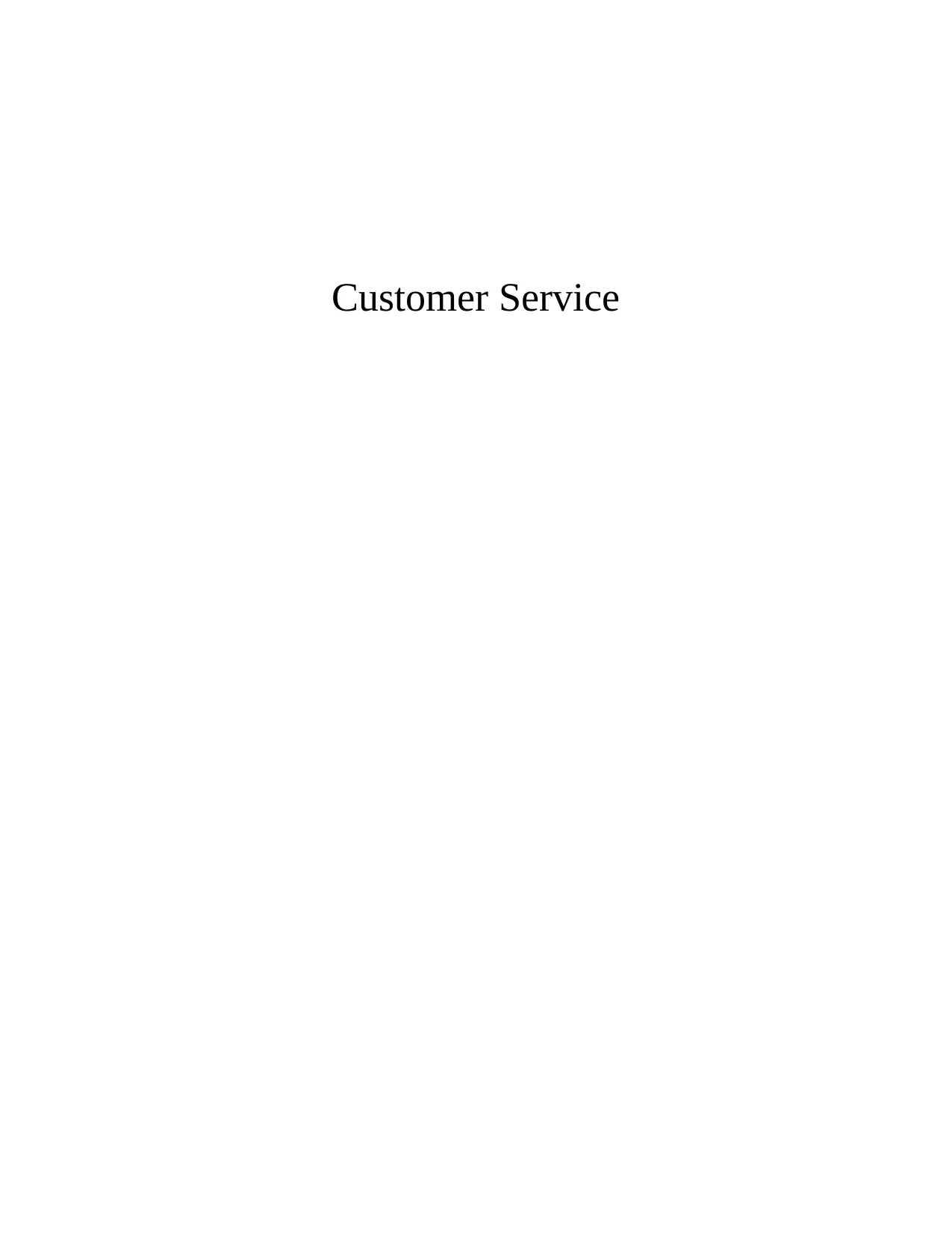
Customer Service
Paraphrase This Document
Need a fresh take? Get an instant paraphrase of this document with our AI Paraphraser
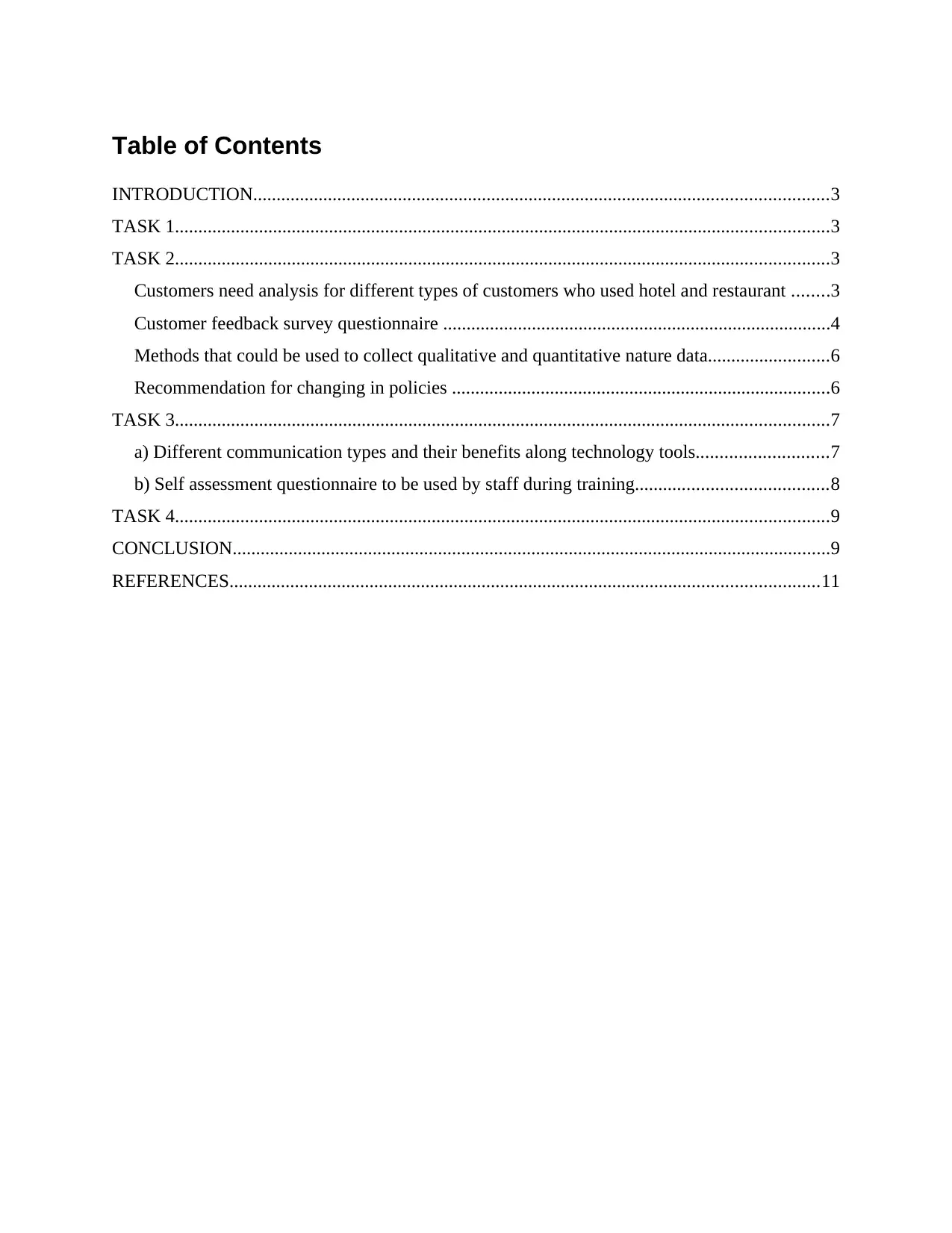
Table of Contents
INTRODUCTION...........................................................................................................................3
TASK 1............................................................................................................................................3
TASK 2............................................................................................................................................3
Customers need analysis for different types of customers who used hotel and restaurant ........3
Customer feedback survey questionnaire ...................................................................................4
Methods that could be used to collect qualitative and quantitative nature data..........................6
Recommendation for changing in policies .................................................................................6
TASK 3............................................................................................................................................7
a) Different communication types and their benefits along technology tools............................7
b) Self assessment questionnaire to be used by staff during training.........................................8
TASK 4............................................................................................................................................9
CONCLUSION................................................................................................................................9
REFERENCES..............................................................................................................................11
INTRODUCTION...........................................................................................................................3
TASK 1............................................................................................................................................3
TASK 2............................................................................................................................................3
Customers need analysis for different types of customers who used hotel and restaurant ........3
Customer feedback survey questionnaire ...................................................................................4
Methods that could be used to collect qualitative and quantitative nature data..........................6
Recommendation for changing in policies .................................................................................6
TASK 3............................................................................................................................................7
a) Different communication types and their benefits along technology tools............................7
b) Self assessment questionnaire to be used by staff during training.........................................8
TASK 4............................................................................................................................................9
CONCLUSION................................................................................................................................9
REFERENCES..............................................................................................................................11
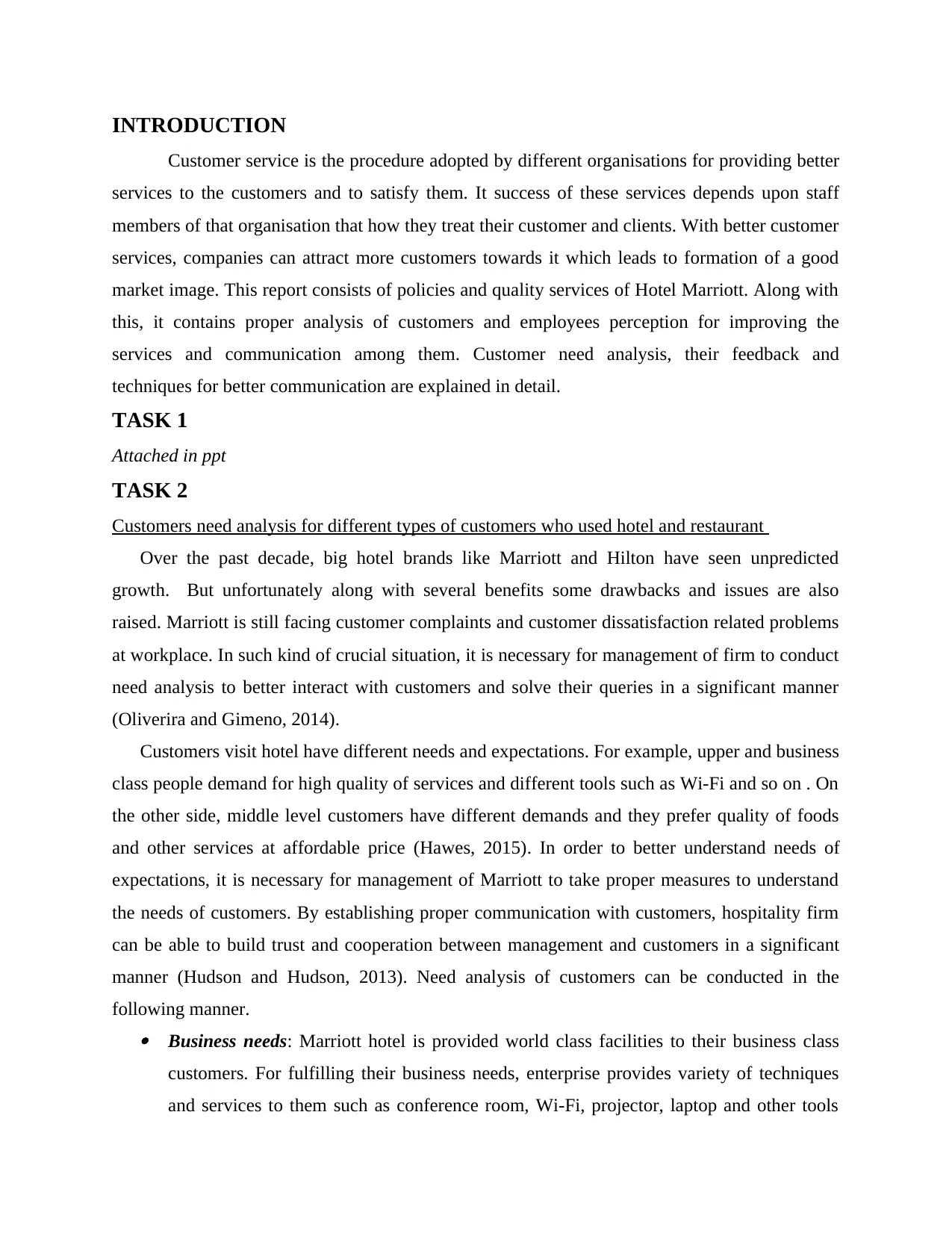
INTRODUCTION
Customer service is the procedure adopted by different organisations for providing better
services to the customers and to satisfy them. It success of these services depends upon staff
members of that organisation that how they treat their customer and clients. With better customer
services, companies can attract more customers towards it which leads to formation of a good
market image. This report consists of policies and quality services of Hotel Marriott. Along with
this, it contains proper analysis of customers and employees perception for improving the
services and communication among them. Customer need analysis, their feedback and
techniques for better communication are explained in detail.
TASK 1
Attached in ppt
TASK 2
Customers need analysis for different types of customers who used hotel and restaurant
Over the past decade, big hotel brands like Marriott and Hilton have seen unpredicted
growth. But unfortunately along with several benefits some drawbacks and issues are also
raised. Marriott is still facing customer complaints and customer dissatisfaction related problems
at workplace. In such kind of crucial situation, it is necessary for management of firm to conduct
need analysis to better interact with customers and solve their queries in a significant manner
(Oliverira and Gimeno, 2014).
Customers visit hotel have different needs and expectations. For example, upper and business
class people demand for high quality of services and different tools such as Wi-Fi and so on . On
the other side, middle level customers have different demands and they prefer quality of foods
and other services at affordable price (Hawes, 2015). In order to better understand needs of
expectations, it is necessary for management of Marriott to take proper measures to understand
the needs of customers. By establishing proper communication with customers, hospitality firm
can be able to build trust and cooperation between management and customers in a significant
manner (Hudson and Hudson, 2013). Need analysis of customers can be conducted in the
following manner. Business needs: Marriott hotel is provided world class facilities to their business class
customers. For fulfilling their business needs, enterprise provides variety of techniques
and services to them such as conference room, Wi-Fi, projector, laptop and other tools
Customer service is the procedure adopted by different organisations for providing better
services to the customers and to satisfy them. It success of these services depends upon staff
members of that organisation that how they treat their customer and clients. With better customer
services, companies can attract more customers towards it which leads to formation of a good
market image. This report consists of policies and quality services of Hotel Marriott. Along with
this, it contains proper analysis of customers and employees perception for improving the
services and communication among them. Customer need analysis, their feedback and
techniques for better communication are explained in detail.
TASK 1
Attached in ppt
TASK 2
Customers need analysis for different types of customers who used hotel and restaurant
Over the past decade, big hotel brands like Marriott and Hilton have seen unpredicted
growth. But unfortunately along with several benefits some drawbacks and issues are also
raised. Marriott is still facing customer complaints and customer dissatisfaction related problems
at workplace. In such kind of crucial situation, it is necessary for management of firm to conduct
need analysis to better interact with customers and solve their queries in a significant manner
(Oliverira and Gimeno, 2014).
Customers visit hotel have different needs and expectations. For example, upper and business
class people demand for high quality of services and different tools such as Wi-Fi and so on . On
the other side, middle level customers have different demands and they prefer quality of foods
and other services at affordable price (Hawes, 2015). In order to better understand needs of
expectations, it is necessary for management of Marriott to take proper measures to understand
the needs of customers. By establishing proper communication with customers, hospitality firm
can be able to build trust and cooperation between management and customers in a significant
manner (Hudson and Hudson, 2013). Need analysis of customers can be conducted in the
following manner. Business needs: Marriott hotel is provided world class facilities to their business class
customers. For fulfilling their business needs, enterprise provides variety of techniques
and services to them such as conference room, Wi-Fi, projector, laptop and other tools
⊘ This is a preview!⊘
Do you want full access?
Subscribe today to unlock all pages.

Trusted by 1+ million students worldwide
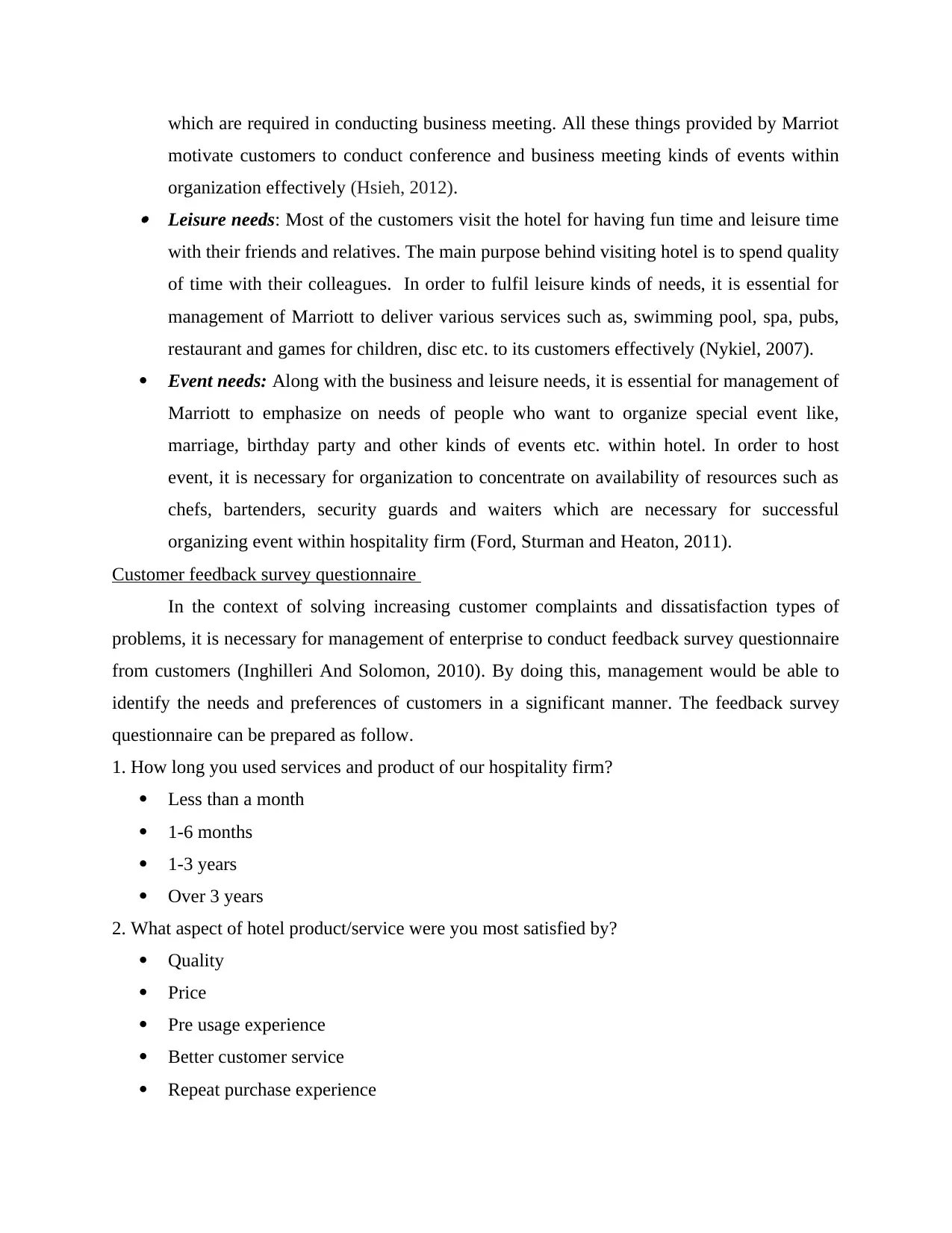
which are required in conducting business meeting. All these things provided by Marriot
motivate customers to conduct conference and business meeting kinds of events within
organization effectively (Hsieh, 2012). Leisure needs: Most of the customers visit the hotel for having fun time and leisure time
with their friends and relatives. The main purpose behind visiting hotel is to spend quality
of time with their colleagues. In order to fulfil leisure kinds of needs, it is essential for
management of Marriott to deliver various services such as, swimming pool, spa, pubs,
restaurant and games for children, disc etc. to its customers effectively (Nykiel, 2007).
Event needs: Along with the business and leisure needs, it is essential for management of
Marriott to emphasize on needs of people who want to organize special event like,
marriage, birthday party and other kinds of events etc. within hotel. In order to host
event, it is necessary for organization to concentrate on availability of resources such as
chefs, bartenders, security guards and waiters which are necessary for successful
organizing event within hospitality firm (Ford, Sturman and Heaton, 2011).
Customer feedback survey questionnaire
In the context of solving increasing customer complaints and dissatisfaction types of
problems, it is necessary for management of enterprise to conduct feedback survey questionnaire
from customers (Inghilleri And Solomon, 2010). By doing this, management would be able to
identify the needs and preferences of customers in a significant manner. The feedback survey
questionnaire can be prepared as follow.
1. How long you used services and product of our hospitality firm?
Less than a month
1-6 months
1-3 years
Over 3 years
2. What aspect of hotel product/service were you most satisfied by?
Quality
Price
Pre usage experience
Better customer service
Repeat purchase experience
motivate customers to conduct conference and business meeting kinds of events within
organization effectively (Hsieh, 2012). Leisure needs: Most of the customers visit the hotel for having fun time and leisure time
with their friends and relatives. The main purpose behind visiting hotel is to spend quality
of time with their colleagues. In order to fulfil leisure kinds of needs, it is essential for
management of Marriott to deliver various services such as, swimming pool, spa, pubs,
restaurant and games for children, disc etc. to its customers effectively (Nykiel, 2007).
Event needs: Along with the business and leisure needs, it is essential for management of
Marriott to emphasize on needs of people who want to organize special event like,
marriage, birthday party and other kinds of events etc. within hotel. In order to host
event, it is necessary for organization to concentrate on availability of resources such as
chefs, bartenders, security guards and waiters which are necessary for successful
organizing event within hospitality firm (Ford, Sturman and Heaton, 2011).
Customer feedback survey questionnaire
In the context of solving increasing customer complaints and dissatisfaction types of
problems, it is necessary for management of enterprise to conduct feedback survey questionnaire
from customers (Inghilleri And Solomon, 2010). By doing this, management would be able to
identify the needs and preferences of customers in a significant manner. The feedback survey
questionnaire can be prepared as follow.
1. How long you used services and product of our hospitality firm?
Less than a month
1-6 months
1-3 years
Over 3 years
2. What aspect of hotel product/service were you most satisfied by?
Quality
Price
Pre usage experience
Better customer service
Repeat purchase experience
Paraphrase This Document
Need a fresh take? Get an instant paraphrase of this document with our AI Paraphraser
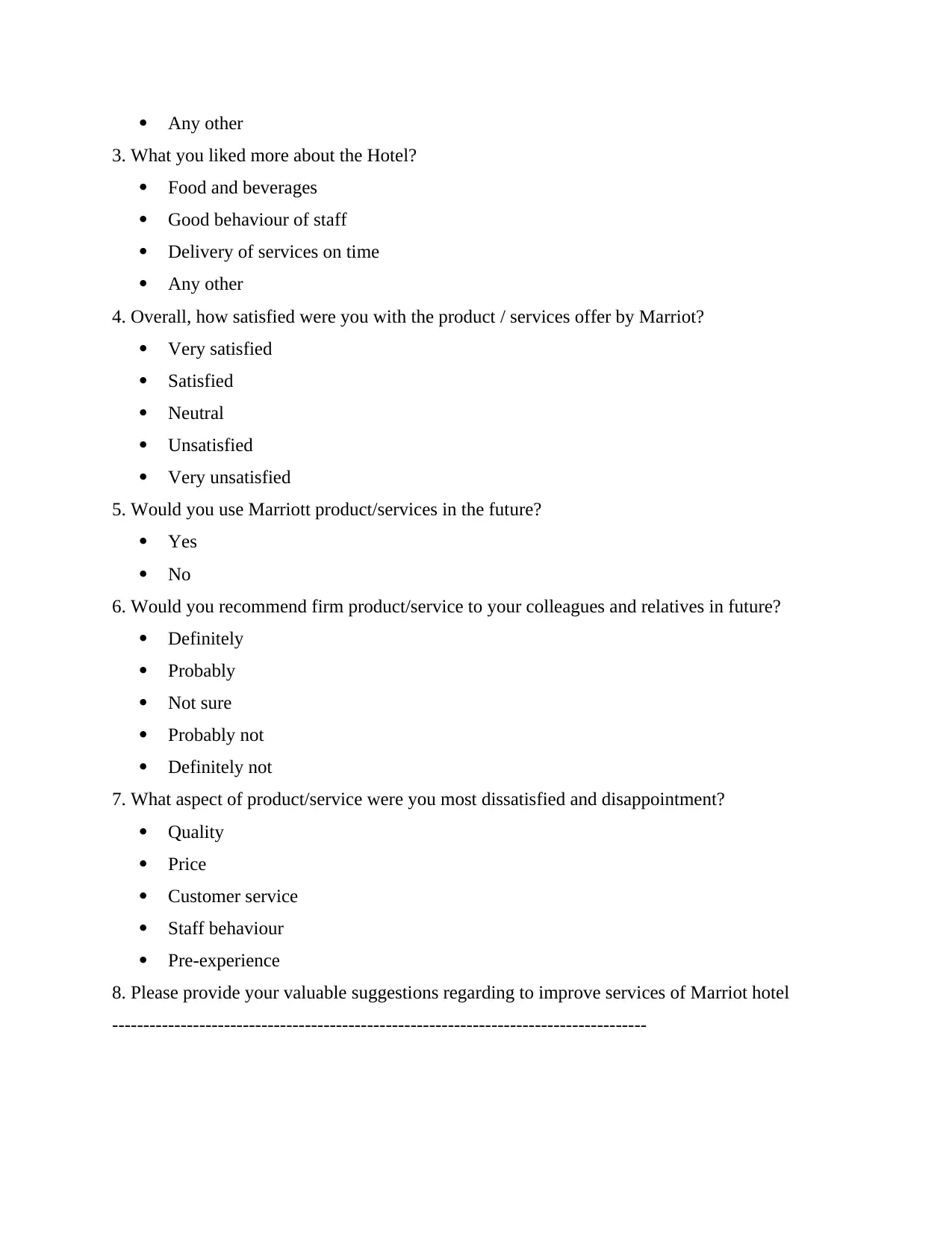
Any other
3. What you liked more about the Hotel?
Food and beverages
Good behaviour of staff
Delivery of services on time
Any other
4. Overall, how satisfied were you with the product / services offer by Marriot?
Very satisfied
Satisfied
Neutral
Unsatisfied
Very unsatisfied
5. Would you use Marriott product/services in the future?
Yes
No
6. Would you recommend firm product/service to your colleagues and relatives in future?
Definitely
Probably
Not sure
Probably not
Definitely not
7. What aspect of product/service were you most dissatisfied and disappointment?
Quality
Price
Customer service
Staff behaviour
Pre-experience
8. Please provide your valuable suggestions regarding to improve services of Marriot hotel
--------------------------------------------------------------------------------------
3. What you liked more about the Hotel?
Food and beverages
Good behaviour of staff
Delivery of services on time
Any other
4. Overall, how satisfied were you with the product / services offer by Marriot?
Very satisfied
Satisfied
Neutral
Unsatisfied
Very unsatisfied
5. Would you use Marriott product/services in the future?
Yes
No
6. Would you recommend firm product/service to your colleagues and relatives in future?
Definitely
Probably
Not sure
Probably not
Definitely not
7. What aspect of product/service were you most dissatisfied and disappointment?
Quality
Price
Customer service
Staff behaviour
Pre-experience
8. Please provide your valuable suggestions regarding to improve services of Marriot hotel
--------------------------------------------------------------------------------------
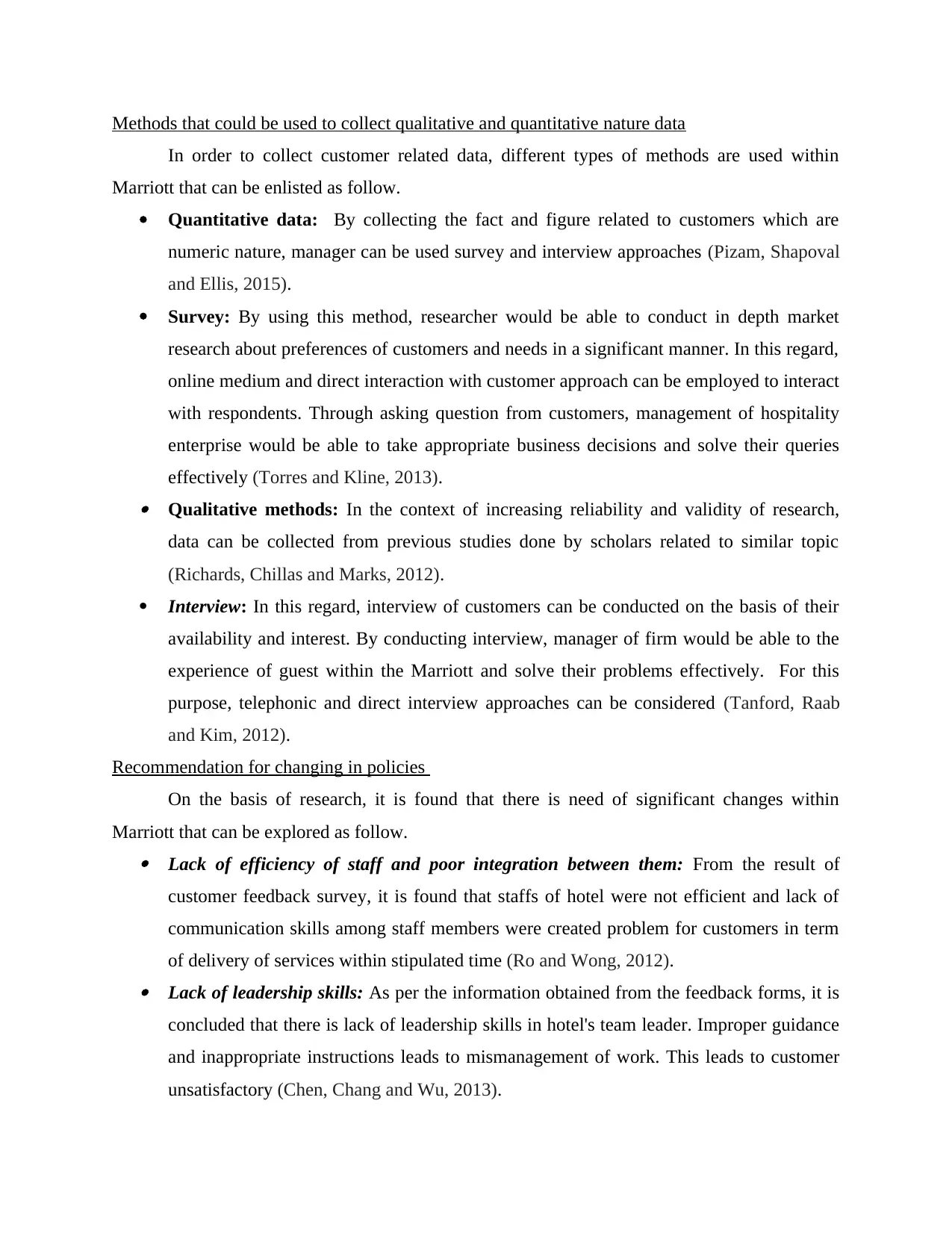
Methods that could be used to collect qualitative and quantitative nature data
In order to collect customer related data, different types of methods are used within
Marriott that can be enlisted as follow.
Quantitative data: By collecting the fact and figure related to customers which are
numeric nature, manager can be used survey and interview approaches (Pizam, Shapoval
and Ellis, 2015).
Survey: By using this method, researcher would be able to conduct in depth market
research about preferences of customers and needs in a significant manner. In this regard,
online medium and direct interaction with customer approach can be employed to interact
with respondents. Through asking question from customers, management of hospitality
enterprise would be able to take appropriate business decisions and solve their queries
effectively (Torres and Kline, 2013). Qualitative methods: In the context of increasing reliability and validity of research,
data can be collected from previous studies done by scholars related to similar topic
(Richards, Chillas and Marks, 2012).
Interview: In this regard, interview of customers can be conducted on the basis of their
availability and interest. By conducting interview, manager of firm would be able to the
experience of guest within the Marriott and solve their problems effectively. For this
purpose, telephonic and direct interview approaches can be considered (Tanford, Raab
and Kim, 2012).
Recommendation for changing in policies
On the basis of research, it is found that there is need of significant changes within
Marriott that can be explored as follow. Lack of efficiency of staff and poor integration between them: From the result of
customer feedback survey, it is found that staffs of hotel were not efficient and lack of
communication skills among staff members were created problem for customers in term
of delivery of services within stipulated time (Ro and Wong, 2012). Lack of leadership skills: As per the information obtained from the feedback forms, it is
concluded that there is lack of leadership skills in hotel's team leader. Improper guidance
and inappropriate instructions leads to mismanagement of work. This leads to customer
unsatisfactory (Chen, Chang and Wu, 2013).
In order to collect customer related data, different types of methods are used within
Marriott that can be enlisted as follow.
Quantitative data: By collecting the fact and figure related to customers which are
numeric nature, manager can be used survey and interview approaches (Pizam, Shapoval
and Ellis, 2015).
Survey: By using this method, researcher would be able to conduct in depth market
research about preferences of customers and needs in a significant manner. In this regard,
online medium and direct interaction with customer approach can be employed to interact
with respondents. Through asking question from customers, management of hospitality
enterprise would be able to take appropriate business decisions and solve their queries
effectively (Torres and Kline, 2013). Qualitative methods: In the context of increasing reliability and validity of research,
data can be collected from previous studies done by scholars related to similar topic
(Richards, Chillas and Marks, 2012).
Interview: In this regard, interview of customers can be conducted on the basis of their
availability and interest. By conducting interview, manager of firm would be able to the
experience of guest within the Marriott and solve their problems effectively. For this
purpose, telephonic and direct interview approaches can be considered (Tanford, Raab
and Kim, 2012).
Recommendation for changing in policies
On the basis of research, it is found that there is need of significant changes within
Marriott that can be explored as follow. Lack of efficiency of staff and poor integration between them: From the result of
customer feedback survey, it is found that staffs of hotel were not efficient and lack of
communication skills among staff members were created problem for customers in term
of delivery of services within stipulated time (Ro and Wong, 2012). Lack of leadership skills: As per the information obtained from the feedback forms, it is
concluded that there is lack of leadership skills in hotel's team leader. Improper guidance
and inappropriate instructions leads to mismanagement of work. This leads to customer
unsatisfactory (Chen, Chang and Wu, 2013).
⊘ This is a preview!⊘
Do you want full access?
Subscribe today to unlock all pages.

Trusted by 1+ million students worldwide
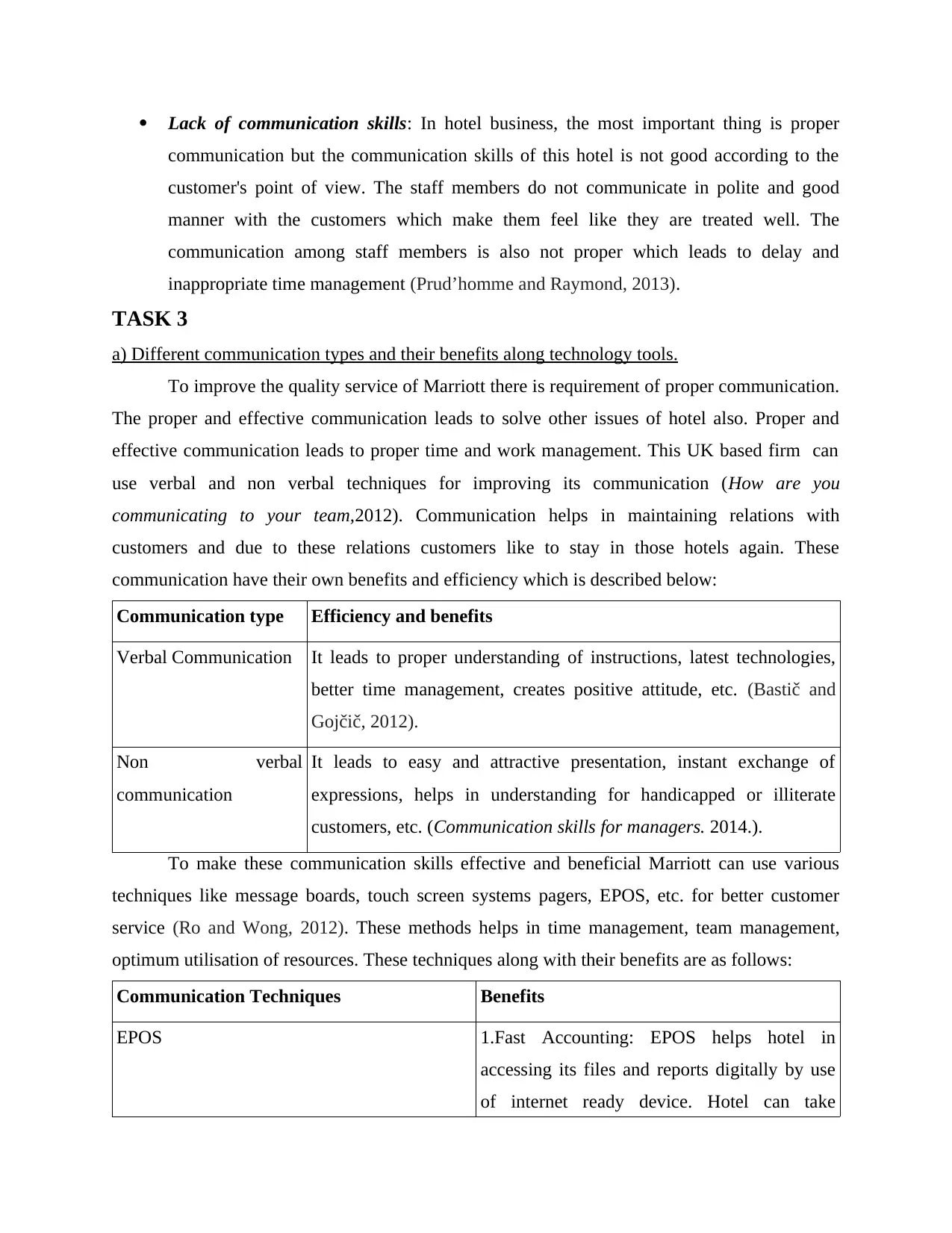
Lack of communication skills: In hotel business, the most important thing is proper
communication but the communication skills of this hotel is not good according to the
customer's point of view. The staff members do not communicate in polite and good
manner with the customers which make them feel like they are treated well. The
communication among staff members is also not proper which leads to delay and
inappropriate time management (Prud’homme and Raymond, 2013).
TASK 3
a) Different communication types and their benefits along technology tools.
To improve the quality service of Marriott there is requirement of proper communication.
The proper and effective communication leads to solve other issues of hotel also. Proper and
effective communication leads to proper time and work management. This UK based firm can
use verbal and non verbal techniques for improving its communication (How are you
communicating to your team,2012). Communication helps in maintaining relations with
customers and due to these relations customers like to stay in those hotels again. These
communication have their own benefits and efficiency which is described below:
Communication type Efficiency and benefits
Verbal Communication It leads to proper understanding of instructions, latest technologies,
better time management, creates positive attitude, etc. (Bastič and
Gojčič, 2012).
Non verbal
communication
It leads to easy and attractive presentation, instant exchange of
expressions, helps in understanding for handicapped or illiterate
customers, etc. (Communication skills for managers. 2014.).
To make these communication skills effective and beneficial Marriott can use various
techniques like message boards, touch screen systems pagers, EPOS, etc. for better customer
service (Ro and Wong, 2012). These methods helps in time management, team management,
optimum utilisation of resources. These techniques along with their benefits are as follows:
Communication Techniques Benefits
EPOS 1.Fast Accounting: EPOS helps hotel in
accessing its files and reports digitally by use
of internet ready device. Hotel can take
communication but the communication skills of this hotel is not good according to the
customer's point of view. The staff members do not communicate in polite and good
manner with the customers which make them feel like they are treated well. The
communication among staff members is also not proper which leads to delay and
inappropriate time management (Prud’homme and Raymond, 2013).
TASK 3
a) Different communication types and their benefits along technology tools.
To improve the quality service of Marriott there is requirement of proper communication.
The proper and effective communication leads to solve other issues of hotel also. Proper and
effective communication leads to proper time and work management. This UK based firm can
use verbal and non verbal techniques for improving its communication (How are you
communicating to your team,2012). Communication helps in maintaining relations with
customers and due to these relations customers like to stay in those hotels again. These
communication have their own benefits and efficiency which is described below:
Communication type Efficiency and benefits
Verbal Communication It leads to proper understanding of instructions, latest technologies,
better time management, creates positive attitude, etc. (Bastič and
Gojčič, 2012).
Non verbal
communication
It leads to easy and attractive presentation, instant exchange of
expressions, helps in understanding for handicapped or illiterate
customers, etc. (Communication skills for managers. 2014.).
To make these communication skills effective and beneficial Marriott can use various
techniques like message boards, touch screen systems pagers, EPOS, etc. for better customer
service (Ro and Wong, 2012). These methods helps in time management, team management,
optimum utilisation of resources. These techniques along with their benefits are as follows:
Communication Techniques Benefits
EPOS 1.Fast Accounting: EPOS helps hotel in
accessing its files and reports digitally by use
of internet ready device. Hotel can take
Paraphrase This Document
Need a fresh take? Get an instant paraphrase of this document with our AI Paraphraser
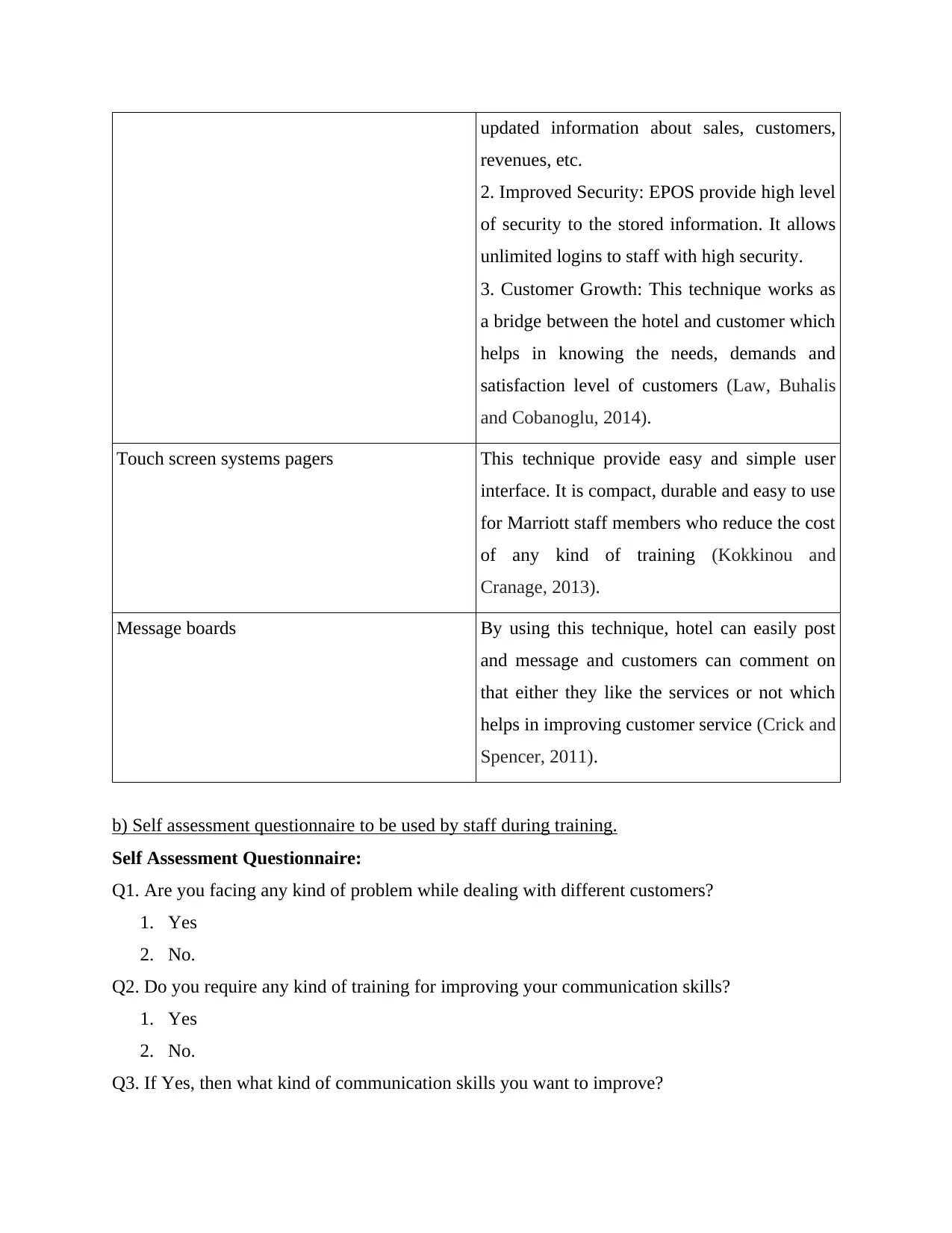
updated information about sales, customers,
revenues, etc.
2. Improved Security: EPOS provide high level
of security to the stored information. It allows
unlimited logins to staff with high security.
3. Customer Growth: This technique works as
a bridge between the hotel and customer which
helps in knowing the needs, demands and
satisfaction level of customers (Law, Buhalis
and Cobanoglu, 2014).
Touch screen systems pagers This technique provide easy and simple user
interface. It is compact, durable and easy to use
for Marriott staff members who reduce the cost
of any kind of training (Kokkinou and
Cranage, 2013).
Message boards By using this technique, hotel can easily post
and message and customers can comment on
that either they like the services or not which
helps in improving customer service (Crick and
Spencer, 2011).
b) Self assessment questionnaire to be used by staff during training.
Self Assessment Questionnaire:
Q1. Are you facing any kind of problem while dealing with different customers?
1. Yes
2. No.
Q2. Do you require any kind of training for improving your communication skills?
1. Yes
2. No.
Q3. If Yes, then what kind of communication skills you want to improve?
revenues, etc.
2. Improved Security: EPOS provide high level
of security to the stored information. It allows
unlimited logins to staff with high security.
3. Customer Growth: This technique works as
a bridge between the hotel and customer which
helps in knowing the needs, demands and
satisfaction level of customers (Law, Buhalis
and Cobanoglu, 2014).
Touch screen systems pagers This technique provide easy and simple user
interface. It is compact, durable and easy to use
for Marriott staff members who reduce the cost
of any kind of training (Kokkinou and
Cranage, 2013).
Message boards By using this technique, hotel can easily post
and message and customers can comment on
that either they like the services or not which
helps in improving customer service (Crick and
Spencer, 2011).
b) Self assessment questionnaire to be used by staff during training.
Self Assessment Questionnaire:
Q1. Are you facing any kind of problem while dealing with different customers?
1. Yes
2. No.
Q2. Do you require any kind of training for improving your communication skills?
1. Yes
2. No.
Q3. If Yes, then what kind of communication skills you want to improve?
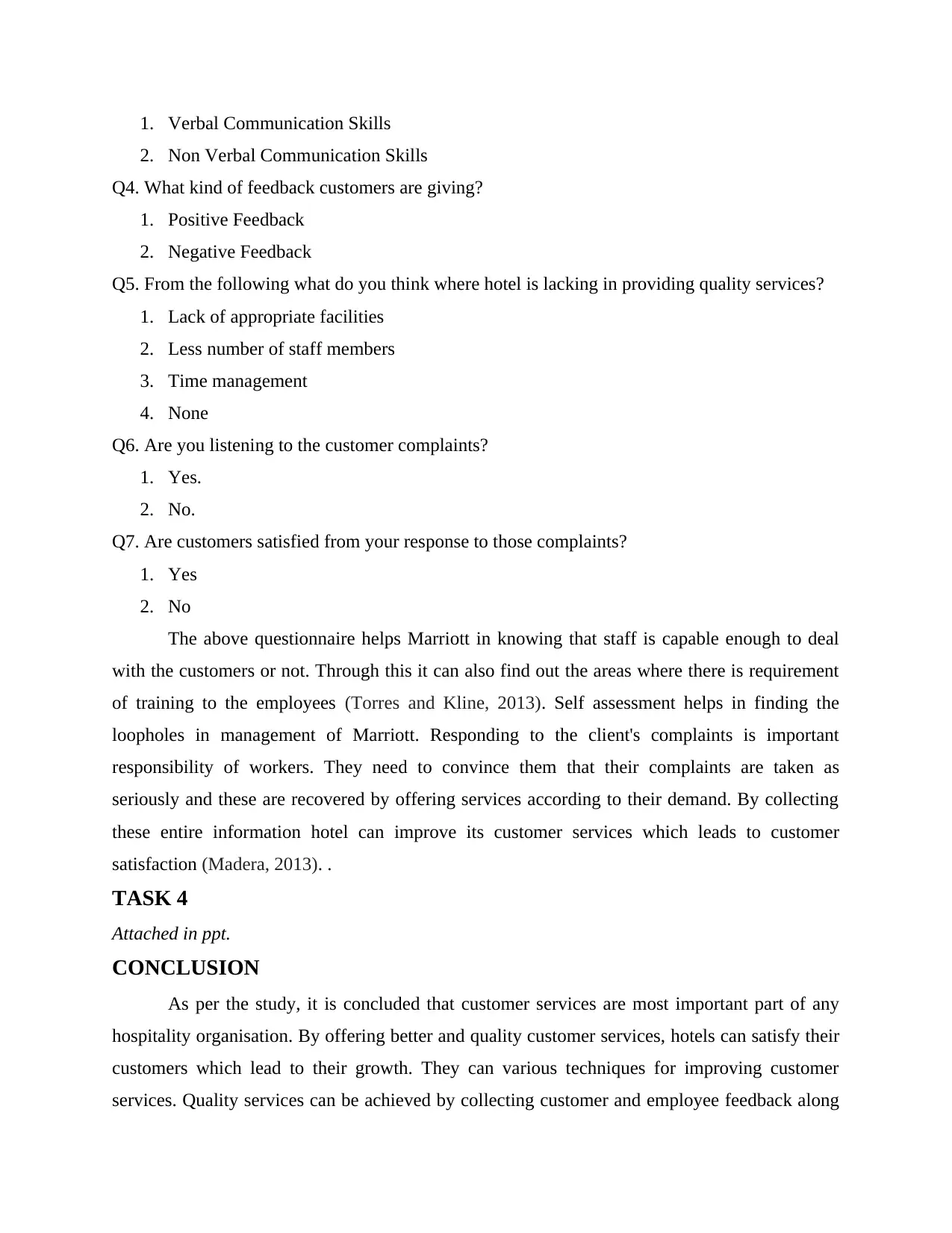
1. Verbal Communication Skills
2. Non Verbal Communication Skills
Q4. What kind of feedback customers are giving?
1. Positive Feedback
2. Negative Feedback
Q5. From the following what do you think where hotel is lacking in providing quality services?
1. Lack of appropriate facilities
2. Less number of staff members
3. Time management
4. None
Q6. Are you listening to the customer complaints?
1. Yes.
2. No.
Q7. Are customers satisfied from your response to those complaints?
1. Yes
2. No
The above questionnaire helps Marriott in knowing that staff is capable enough to deal
with the customers or not. Through this it can also find out the areas where there is requirement
of training to the employees (Torres and Kline, 2013). Self assessment helps in finding the
loopholes in management of Marriott. Responding to the client's complaints is important
responsibility of workers. They need to convince them that their complaints are taken as
seriously and these are recovered by offering services according to their demand. By collecting
these entire information hotel can improve its customer services which leads to customer
satisfaction (Madera, 2013). .
TASK 4
Attached in ppt.
CONCLUSION
As per the study, it is concluded that customer services are most important part of any
hospitality organisation. By offering better and quality customer services, hotels can satisfy their
customers which lead to their growth. They can various techniques for improving customer
services. Quality services can be achieved by collecting customer and employee feedback along
2. Non Verbal Communication Skills
Q4. What kind of feedback customers are giving?
1. Positive Feedback
2. Negative Feedback
Q5. From the following what do you think where hotel is lacking in providing quality services?
1. Lack of appropriate facilities
2. Less number of staff members
3. Time management
4. None
Q6. Are you listening to the customer complaints?
1. Yes.
2. No.
Q7. Are customers satisfied from your response to those complaints?
1. Yes
2. No
The above questionnaire helps Marriott in knowing that staff is capable enough to deal
with the customers or not. Through this it can also find out the areas where there is requirement
of training to the employees (Torres and Kline, 2013). Self assessment helps in finding the
loopholes in management of Marriott. Responding to the client's complaints is important
responsibility of workers. They need to convince them that their complaints are taken as
seriously and these are recovered by offering services according to their demand. By collecting
these entire information hotel can improve its customer services which leads to customer
satisfaction (Madera, 2013). .
TASK 4
Attached in ppt.
CONCLUSION
As per the study, it is concluded that customer services are most important part of any
hospitality organisation. By offering better and quality customer services, hotels can satisfy their
customers which lead to their growth. They can various techniques for improving customer
services. Quality services can be achieved by collecting customer and employee feedback along
⊘ This is a preview!⊘
Do you want full access?
Subscribe today to unlock all pages.

Trusted by 1+ million students worldwide
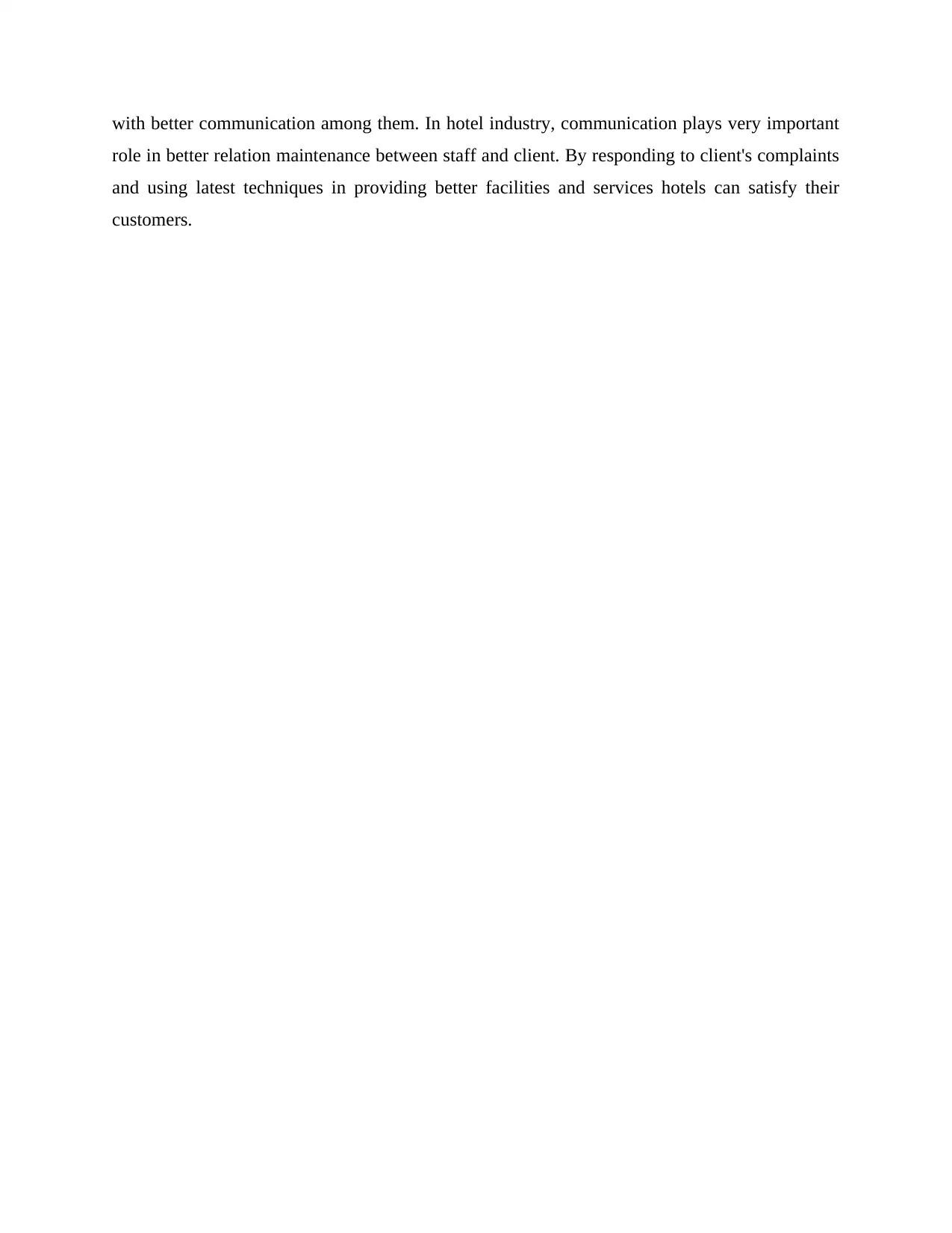
with better communication among them. In hotel industry, communication plays very important
role in better relation maintenance between staff and client. By responding to client's complaints
and using latest techniques in providing better facilities and services hotels can satisfy their
customers.
role in better relation maintenance between staff and client. By responding to client's complaints
and using latest techniques in providing better facilities and services hotels can satisfy their
customers.
Paraphrase This Document
Need a fresh take? Get an instant paraphrase of this document with our AI Paraphraser
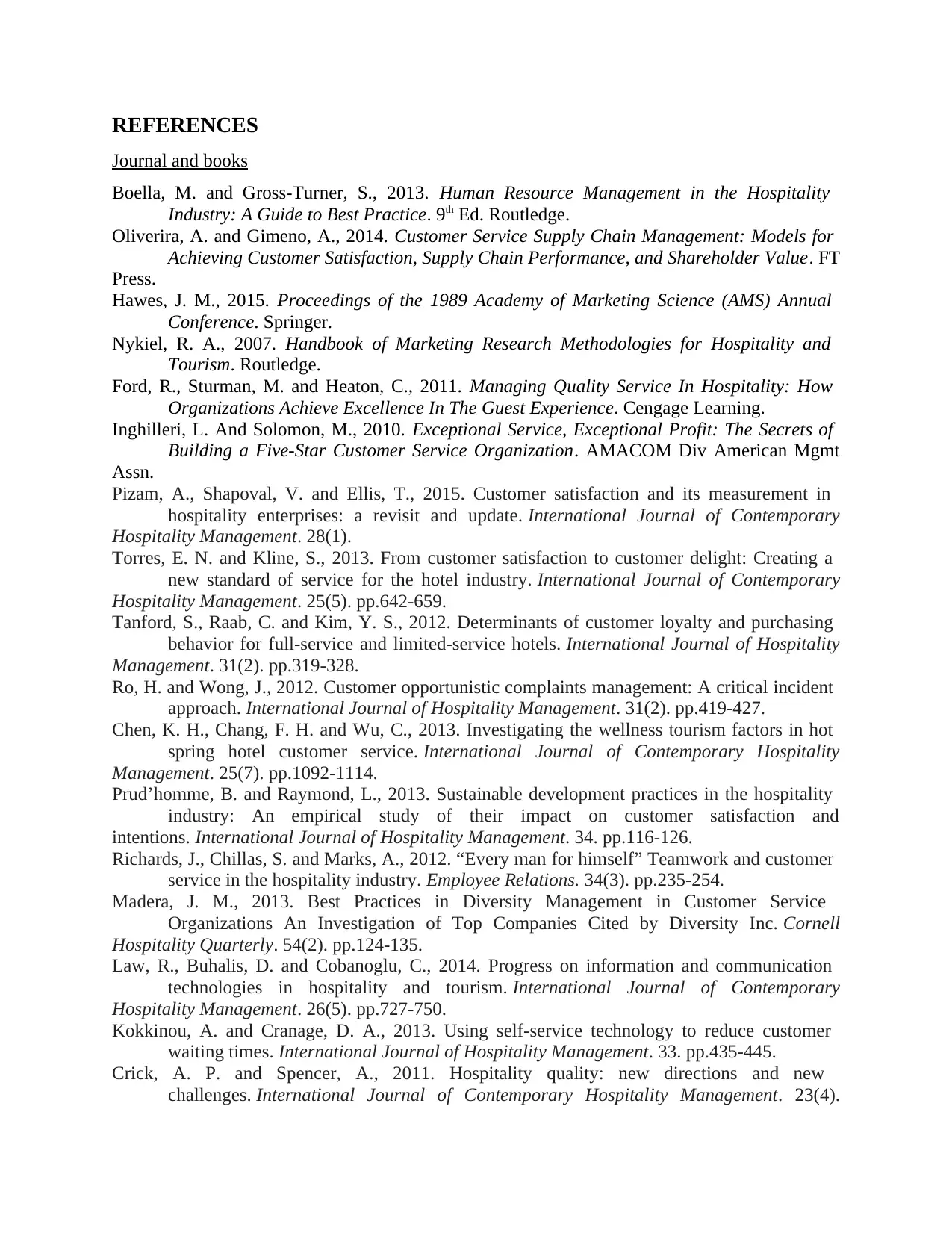
REFERENCES
Journal and books
Boella, M. and Gross-Turner, S., 2013. Human Resource Management in the Hospitality
Industry: A Guide to Best Practice. 9th Ed. Routledge.
Oliverira, A. and Gimeno, A., 2014. Customer Service Supply Chain Management: Models for
Achieving Customer Satisfaction, Supply Chain Performance, and Shareholder Value. FT
Press.
Hawes, J. M., 2015. Proceedings of the 1989 Academy of Marketing Science (AMS) Annual
Conference. Springer.
Nykiel, R. A., 2007. Handbook of Marketing Research Methodologies for Hospitality and
Tourism. Routledge.
Ford, R., Sturman, M. and Heaton, C., 2011. Managing Quality Service In Hospitality: How
Organizations Achieve Excellence In The Guest Experience. Cengage Learning.
Inghilleri, L. And Solomon, M., 2010. Exceptional Service, Exceptional Profit: The Secrets of
Building a Five-Star Customer Service Organization. AMACOM Div American Mgmt
Assn.
Pizam, A., Shapoval, V. and Ellis, T., 2015. Customer satisfaction and its measurement in
hospitality enterprises: a revisit and update. International Journal of Contemporary
Hospitality Management. 28(1).
Torres, E. N. and Kline, S., 2013. From customer satisfaction to customer delight: Creating a
new standard of service for the hotel industry. International Journal of Contemporary
Hospitality Management. 25(5). pp.642-659.
Tanford, S., Raab, C. and Kim, Y. S., 2012. Determinants of customer loyalty and purchasing
behavior for full-service and limited-service hotels. International Journal of Hospitality
Management. 31(2). pp.319-328.
Ro, H. and Wong, J., 2012. Customer opportunistic complaints management: A critical incident
approach. International Journal of Hospitality Management. 31(2). pp.419-427.
Chen, K. H., Chang, F. H. and Wu, C., 2013. Investigating the wellness tourism factors in hot
spring hotel customer service. International Journal of Contemporary Hospitality
Management. 25(7). pp.1092-1114.
Prud’homme, B. and Raymond, L., 2013. Sustainable development practices in the hospitality
industry: An empirical study of their impact on customer satisfaction and
intentions. International Journal of Hospitality Management. 34. pp.116-126.
Richards, J., Chillas, S. and Marks, A., 2012. “Every man for himself” Teamwork and customer
service in the hospitality industry. Employee Relations. 34(3). pp.235-254.
Madera, J. M., 2013. Best Practices in Diversity Management in Customer Service
Organizations An Investigation of Top Companies Cited by Diversity Inc. Cornell
Hospitality Quarterly. 54(2). pp.124-135.
Law, R., Buhalis, D. and Cobanoglu, C., 2014. Progress on information and communication
technologies in hospitality and tourism. International Journal of Contemporary
Hospitality Management. 26(5). pp.727-750.
Kokkinou, A. and Cranage, D. A., 2013. Using self-service technology to reduce customer
waiting times. International Journal of Hospitality Management. 33. pp.435-445.
Crick, A. P. and Spencer, A., 2011. Hospitality quality: new directions and new
challenges. International Journal of Contemporary Hospitality Management. 23(4).
Journal and books
Boella, M. and Gross-Turner, S., 2013. Human Resource Management in the Hospitality
Industry: A Guide to Best Practice. 9th Ed. Routledge.
Oliverira, A. and Gimeno, A., 2014. Customer Service Supply Chain Management: Models for
Achieving Customer Satisfaction, Supply Chain Performance, and Shareholder Value. FT
Press.
Hawes, J. M., 2015. Proceedings of the 1989 Academy of Marketing Science (AMS) Annual
Conference. Springer.
Nykiel, R. A., 2007. Handbook of Marketing Research Methodologies for Hospitality and
Tourism. Routledge.
Ford, R., Sturman, M. and Heaton, C., 2011. Managing Quality Service In Hospitality: How
Organizations Achieve Excellence In The Guest Experience. Cengage Learning.
Inghilleri, L. And Solomon, M., 2010. Exceptional Service, Exceptional Profit: The Secrets of
Building a Five-Star Customer Service Organization. AMACOM Div American Mgmt
Assn.
Pizam, A., Shapoval, V. and Ellis, T., 2015. Customer satisfaction and its measurement in
hospitality enterprises: a revisit and update. International Journal of Contemporary
Hospitality Management. 28(1).
Torres, E. N. and Kline, S., 2013. From customer satisfaction to customer delight: Creating a
new standard of service for the hotel industry. International Journal of Contemporary
Hospitality Management. 25(5). pp.642-659.
Tanford, S., Raab, C. and Kim, Y. S., 2012. Determinants of customer loyalty and purchasing
behavior for full-service and limited-service hotels. International Journal of Hospitality
Management. 31(2). pp.319-328.
Ro, H. and Wong, J., 2012. Customer opportunistic complaints management: A critical incident
approach. International Journal of Hospitality Management. 31(2). pp.419-427.
Chen, K. H., Chang, F. H. and Wu, C., 2013. Investigating the wellness tourism factors in hot
spring hotel customer service. International Journal of Contemporary Hospitality
Management. 25(7). pp.1092-1114.
Prud’homme, B. and Raymond, L., 2013. Sustainable development practices in the hospitality
industry: An empirical study of their impact on customer satisfaction and
intentions. International Journal of Hospitality Management. 34. pp.116-126.
Richards, J., Chillas, S. and Marks, A., 2012. “Every man for himself” Teamwork and customer
service in the hospitality industry. Employee Relations. 34(3). pp.235-254.
Madera, J. M., 2013. Best Practices in Diversity Management in Customer Service
Organizations An Investigation of Top Companies Cited by Diversity Inc. Cornell
Hospitality Quarterly. 54(2). pp.124-135.
Law, R., Buhalis, D. and Cobanoglu, C., 2014. Progress on information and communication
technologies in hospitality and tourism. International Journal of Contemporary
Hospitality Management. 26(5). pp.727-750.
Kokkinou, A. and Cranage, D. A., 2013. Using self-service technology to reduce customer
waiting times. International Journal of Hospitality Management. 33. pp.435-445.
Crick, A. P. and Spencer, A., 2011. Hospitality quality: new directions and new
challenges. International Journal of Contemporary Hospitality Management. 23(4).
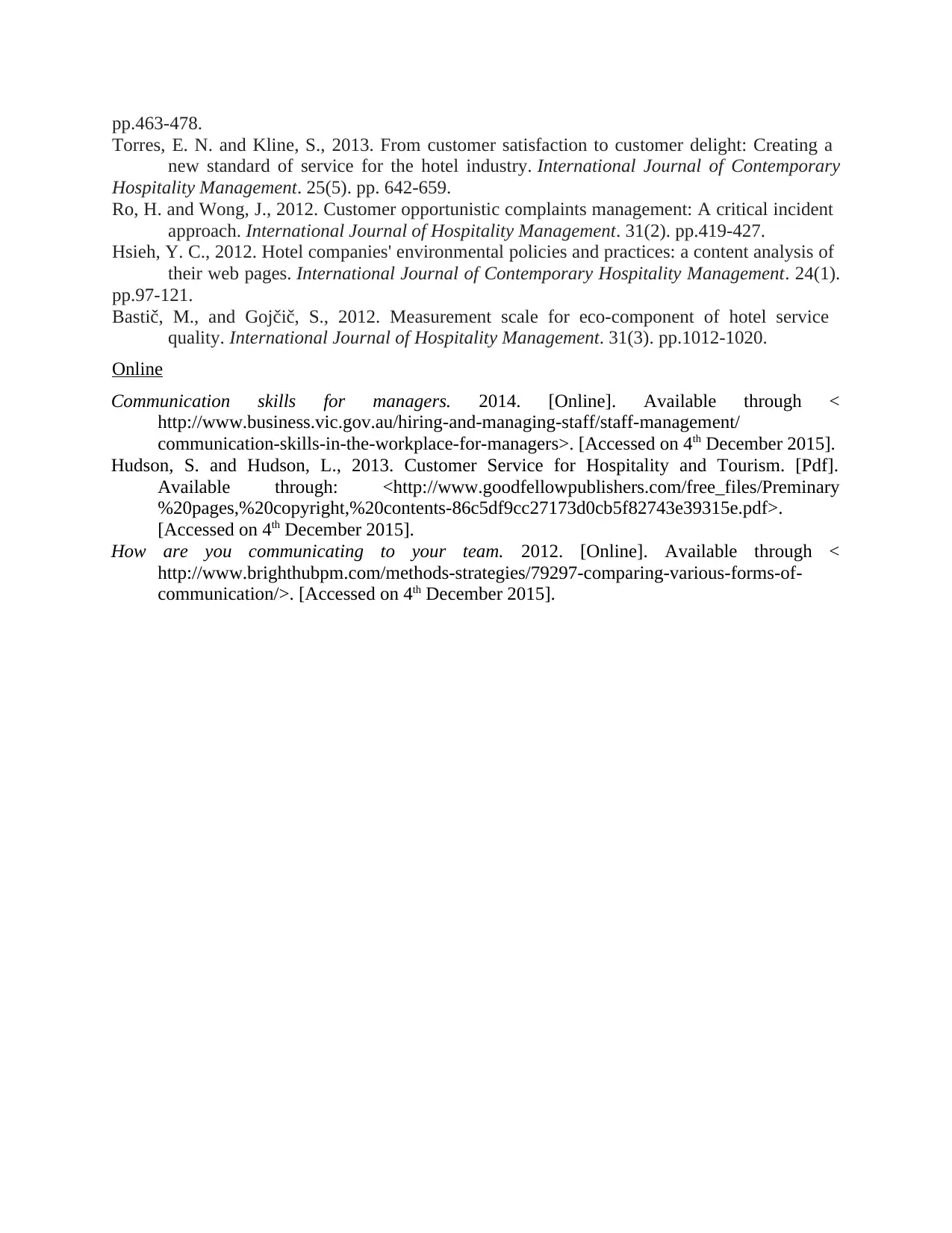
pp.463-478.
Torres, E. N. and Kline, S., 2013. From customer satisfaction to customer delight: Creating a
new standard of service for the hotel industry. International Journal of Contemporary
Hospitality Management. 25(5). pp. 642-659.
Ro, H. and Wong, J., 2012. Customer opportunistic complaints management: A critical incident
approach. International Journal of Hospitality Management. 31(2). pp.419-427.
Hsieh, Y. C., 2012. Hotel companies' environmental policies and practices: a content analysis of
their web pages. International Journal of Contemporary Hospitality Management. 24(1).
pp.97-121.
Bastič, M., and Gojčič, S., 2012. Measurement scale for eco-component of hotel service
quality. International Journal of Hospitality Management. 31(3). pp.1012-1020.
Online
Communication skills for managers. 2014. [Online]. Available through <
http://www.business.vic.gov.au/hiring-and-managing-staff/staff-management/
communication-skills-in-the-workplace-for-managers>. [Accessed on 4th December 2015].
Hudson, S. and Hudson, L., 2013. Customer Service for Hospitality and Tourism. [Pdf].
Available through: <http://www.goodfellowpublishers.com/free_files/Preminary
%20pages,%20copyright,%20contents-86c5df9cc27173d0cb5f82743e39315e.pdf>.
[Accessed on 4th December 2015].
How are you communicating to your team. 2012. [Online]. Available through <
http://www.brighthubpm.com/methods-strategies/79297-comparing-various-forms-of-
communication/>. [Accessed on 4th December 2015].
Torres, E. N. and Kline, S., 2013. From customer satisfaction to customer delight: Creating a
new standard of service for the hotel industry. International Journal of Contemporary
Hospitality Management. 25(5). pp. 642-659.
Ro, H. and Wong, J., 2012. Customer opportunistic complaints management: A critical incident
approach. International Journal of Hospitality Management. 31(2). pp.419-427.
Hsieh, Y. C., 2012. Hotel companies' environmental policies and practices: a content analysis of
their web pages. International Journal of Contemporary Hospitality Management. 24(1).
pp.97-121.
Bastič, M., and Gojčič, S., 2012. Measurement scale for eco-component of hotel service
quality. International Journal of Hospitality Management. 31(3). pp.1012-1020.
Online
Communication skills for managers. 2014. [Online]. Available through <
http://www.business.vic.gov.au/hiring-and-managing-staff/staff-management/
communication-skills-in-the-workplace-for-managers>. [Accessed on 4th December 2015].
Hudson, S. and Hudson, L., 2013. Customer Service for Hospitality and Tourism. [Pdf].
Available through: <http://www.goodfellowpublishers.com/free_files/Preminary
%20pages,%20copyright,%20contents-86c5df9cc27173d0cb5f82743e39315e.pdf>.
[Accessed on 4th December 2015].
How are you communicating to your team. 2012. [Online]. Available through <
http://www.brighthubpm.com/methods-strategies/79297-comparing-various-forms-of-
communication/>. [Accessed on 4th December 2015].
⊘ This is a preview!⊘
Do you want full access?
Subscribe today to unlock all pages.

Trusted by 1+ million students worldwide
1 out of 12
Related Documents
Your All-in-One AI-Powered Toolkit for Academic Success.
+13062052269
info@desklib.com
Available 24*7 on WhatsApp / Email
![[object Object]](/_next/static/media/star-bottom.7253800d.svg)
Unlock your academic potential
Copyright © 2020–2025 A2Z Services. All Rights Reserved. Developed and managed by ZUCOL.




